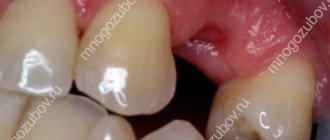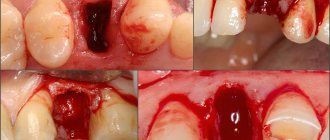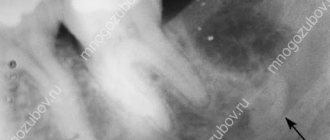Author: Brodsky Sergey Evgenievich Deputy Chief Physician, Candidate of Medical Sciences in the specialties: dentistry and medical microbiology If you have a tooth removed, what should you do after the removal? What should you not do after tooth extraction? When is cold required? What correct actions after tooth extraction will speed up gum healing and reduce pain and swelling? Read on for answers to these and other questions.
Pain after tooth extraction
Why do patients complain that when a tooth is removed everything hurts? Every second dental patient experiences significant pain after tooth extraction. Taking into account how the dental extraction operation went, the period during which the hole (place) hurts after tooth extraction is individual for each person. As a rule, aching or throbbing pain after tooth extraction lasts no more than 4-5 days.
Deputy Chief physician Sergey Evgenievich Brodsky
Sign up for a free consultation
+7
If the “parting with teeth” was severe, then often after tooth extraction the jaw hurts, both lower and upper. All severe pain after tooth extraction is associated with swelling that appears in the area of the surgical wound. In addition, concomitant purulent processes in the oral cavity play an important role, which lead to dental losses. As the stages of the wound process successively change, pain and discomfort in the gums completely stop within 2 to 3 weeks.
Normal and signs of complications
Since tooth extraction is a full-fledged surgical operation, pain is inevitable. During the removal process, nerve endings and blood vessels are injured, bone is injured, so pain in the gums is inevitable.
The following course of the postoperative period is considered normal:
- aching pain (no pulsation, shooting);
- every day the pain becomes less;
- In the first three days, swelling in the area of removal may increase, and from the third day onwards it subsides. After the removal of the lower wisdom teeth, it may be difficult to open the mouth due to swelling or facial asymmetry - this is also normal;
- body temperature is normal or elevated on the first day after removal;
- there is a blood clot in the socket on the first day, on the second day there is a white or grayish film, which is replaced over time by new mucous membrane;
- The gums at the site of removal are red on the first day, and then, every day, they become less swollen and acquire a normal pale pink color.
The strength and severity of all these symptoms depends on the complexity of removal. If a tooth was removed due to periodontal disease, and this tooth was already mobile and its root was 1/3 in the bone, then after removal, the patient may not experience any discomfort on the first day. If the tooth was deep in the bone, and to remove it it was necessary to make an incision, saw out or bite off part of the bone, saw the tooth into pieces and take it out piece by piece, and then apply sutures, then the pain will be normal even within a week.
What symptoms indicate that the healing of the hole is not going properly and there are complications?
- The pain does not decrease every day, but remains at the same level or intensifies;
- the nature of the pain is pulsating;
- in the area of the extracted tooth, the gums are red and painful to touch;
- swelling of the mucous membrane increases (as well as along the transitional fold or in the cheek area);
- the appearance of bad breath;
- elevated temperature.
If inflammation in the socket progresses after removal, this situation is called alveolitis. Such inflammation can occur both due to the fault of the doctor and the fault of the patient.
The dentist may accidentally leave part of the root of the tooth being removed or a movable fragment of bone in the socket, may leave part of the cyst capsule, and may also not control the process of formation of a blood clot. There are cases when, after removal, the gum does not bleed and the socket is dry - the doctor must ensure that the socket is filled with blood, and if there is none, with special preparations to protect the bone.
Through the fault of the patient, alveolitis most often begins due to non-compliance with recommendations:
- active rinsing (as a result of which the clot is washed out and unprotected bone remains);
- eating hot food and drinking on the first day or lifting weights (also leads to increased pressure and removal of the clot from the socket);
- non-compliance with prescriptions (refusal of rinses, antibiotics or other prescribed therapy).
In addition, there are situations where complications after removal are associated with general health. With reduced immunity (due to taking corticosteroids, diabetes, leukemia and other diseases), blood clotting and resistance to infections are impaired - all this can cause alveolitis. If you have complex systemic diseases, you need to warn your doctor about them.
Effective drugs and tablets for pain after tooth extraction:
No. 1. Nise + Nurofen Express + Suprastin
- First, we drink 1 tablet of Suprastin, and after 20 minutes, a tablet of Nise and 1 tablet of Nurofen Express. The combination can be repeated after 4 – 6 hours
No. 2. solpadeine soluble + ketanov + suprastin
- First, we drink 1 tablet of suprastin, after 20 minutes, dissolve 1 tablet of solpadeine in water and drink, after another 15 minutes, drink 1 tablet of ketane. The combination can be repeated twice a day, every 6 hours, or take combination No. 1
Before taking pills, it is advisable to consult a specialist.
Just CALL US!
+7
We will answer any of your questions and will definitely help you!
How to stop bleeding after tooth extraction?
A tooth was pulled out, the bleeding doesn’t stop, what’s the matter? Almost always, after tooth extraction there is bleeding. Bleeding from the tooth socket continues for some time.
This process occurs after the rupture of capillaries and small vessels located in the gum. In addition, during the operation, the alveolar artery, located under the apex of each tooth root, is damaged. As such, blood after tooth extraction is a necessary factor for the healing of the bone socket and gums. However, heavy bleeding after tooth extraction requires medical attention. In some cases, this development of events is a complication, especially with concomitant diseases, such as diabetes mellitus, conditions after taking anticoagulants, blood cancer, high blood pressure, and menstrual periods in women.
What and how to stop bleeding after tooth extraction?
As a rule, the dentist already during the operation sees that the bleeding from the tooth socket is profuse and he himself carries out an intensive tompanade of the socket using gauze swabs soaked in hydrogen peroxide and hemostatic sponges. A tight tomponade for 20 minutes is guaranteed to stop bleeding in 99% of cases. Additionally, cold is applied to the surgical area, which leads to spasm of the arterioles and also helps stop bleeding. If at home there is suddenly bleeding again from the hole of an extracted tooth in the gum, you need to do the following:
- soak gauze or a clean handkerchief in hydrogen peroxide and roll it in several layers
- rinse your mouth with cold water and pour hydrogen peroxide into the dental socket
- press the gauze swab tightly to the hole and hold for 30 -40 minutes
- take a semi-lying position and apply ice in the tissue to the cheek for 1 hour
- sleep on raised pillows at night
- visit the dentist the next day
Swelling after tooth extraction
Swelling and swelling on the face, cheek and chin after wisdom tooth removal, why?
Swelling of varying degrees always occurs after tooth extraction. This is a universal physiological reaction of the body aimed at protecting organs and tissues in contact with the removed organ. Moderate, hard or soft, swelling of the surgical wound after removal of the upper, lower, front and back teeth ensures rapid and comfortable healing of the gums and bone alveoli in which the dental roots were located. However, increased (increased) swelling after tooth extraction leads to problems. How to relieve swelling after tooth extraction? After a complex dental extraction operation, which involved sawing and destruction of bone tissue, with the presence of a purulent process in the gums (for example, gumboil), the dentist mandatory prescribes antibacterial and anti-edematous therapy for the oral cavity.
Chief physician, Salatsky Dmitry Nikolaevich
Sign up for a free consultation
+7
An approximate effective combination of antibiotics and antihistamines is:
- Rulid + nimulid + suprastin: 1 tablet of each drug twice a day, for 7 days
Or
- Trichopolum + Avelox + Claritin: 1 tablet of each drug once a day, for 5 days
How long does swelling and swelling last after tooth extraction?
Normally no more than 4 – 5 days. In case of complicated wound healing, from 5 to 14 days. In case of purulent-inflammatory odontogenic diseases of the oral cavity, after the removal of teeth with granulomas and cysts, swelling can last from 3 to 4 weeks.
Cheek swelling: no health threat
There are swelling of the cheeks and painful syndrome after tooth extraction surgery that are unbearably intense and these symptoms carry a certain danger. In what cases should you immediately seek medical help?
- With increasing swelling of the cheek and intense pain. In this case, consultation and additional examination by a dentist is necessary, since growing swelling threatens to suppurate and spread even to the area under the eyes.
- The pain syndrome is severe and there are no signs of a decrease in its intensity. It is important to know here that a very intense pain syndrome can accompany the period only after a complex operation, including the process of sawing out the bone. Such severe pain can continue after such an operation for two to three days. In other cases, after removal, such a symptom is the reason for immediately contacting a doctor.
In cases where the pain cannot be tolerated before seeking medical help, analgesics can be used.
- Tension in the area of the swollen part of the cheek and in the soft tissues gradually increases.
- Body temperature gradually increases or remains at high levels of the thermometer.
- Opening your mouth is a very difficult process, swallowing is painful.
- After removal, a blood clot did not form in the tooth socket, which means inflammation began there, which, accordingly, is the cause of quite severe pain.
- Pain and swelling of the cheek are accompanied by severe shortness of breath and difficulty breathing. Most likely this is an allergic reaction to medications used during tooth extraction surgery. Urgent medical attention is needed, otherwise this can lead to very sad and irreversible consequences, including anaphylactic shock.
- With a pronounced putrid odor from the mouth, indicating, as a rule, the process of rotting that has begun in the hole.
In all these cases, you should not expect or try to relieve the pain on your own. It is necessary to seek help from your dentist.
When swelling of the cheek appears only on the third or fourth day after tooth extraction surgery, as a rule, this is associated with suppuration, which occurs gradually or with the development of an inflammatory process in a dry (when there is no blood clot) socket. In a word, alveolitis develops.
In case of alveolitis, you cannot do without medical help. Using special instruments, the doctor will clean the hole from necrotic tissue decay, fill the hole with medicine, and give recommendations on the patient’s own further actions.
Swelling of the cheek can also begin after a few days if, during surgery, a hematoma has formed in the gum tissue and it begins to fester. And in this case, it is very important to consult a doctor immediately. He, the doctor, opens the hematoma, cleans the gums of pus, and puts in some medicine.
After tooth extraction, temperature
Why and when does an increase in temperature occur after tooth extraction? The situation when a high temperature appears after tooth extraction does not always occur.
As a rule, a temperature of 37 to 38 after tooth extraction is possible in the following cases:
- the presence of a purulent process in the jaw near the tooth (cyst, granuloma, gumboil)
- sleepless night from toothache, one or more, before dental extraction surgery
- complex and traumatic dental extraction surgery, with loss of bone tissue, as well as a jaw fracture
How long does the fever last after tooth extraction? As a rule, no more than 2-4 days after surgery. If the temperature rises after tooth extraction, what should you do? It is necessary to provide the patient with peace, limit movement, it is best to take antihistamines (1 tablet of Suprastin or Claritin) and, if possible, get enough sleep, observing bed rest for 24-48 hours. You need to visit a doctor.
Types of deletion
Wisdom teeth (eights, third molars) are larger than other dental units in the row. They differ not only in size, but also in the complex anatomy of the root system. Eight has from 2 to 6 roots
, which are often closely intertwined with each other. Given the complex arrangement of wisdom teeth, when they are removed, a significant wound is created.
The risk of complications will directly depend on how difficult the figure eight extraction was. With simple extraction, when the tooth is intact, the roots are not intertwined, and there are no other pathologies (pulpitis, periodontitis, etc.), the risk of complications is minimal. In such a situation, the doctor uses forceps or an elevator to remove the tooth from the socket.
If the wisdom tooth is incorrectly positioned (horizontal eruption, severe curvature), intertwined roots, significant destruction of the coronal part, or the presence of inflammation, a more global surgical intervention may be required. An incision in the gum, cutting a tooth into pieces with a drill, removing root fragments through the jaw bone and other manipulations significantly increase the traumatic nature of the procedure. Aching pain, swelling after removal of the figure eight, increased temperature (up to 37.5℃), hematoma on the cheek - this is a normal reaction to the intervention, which lasts no more than 5-7 days.
Swollen cheek after tooth extraction
If your cheek is swollen after tooth extraction, what should you do?
Swelling of the cheek after wisdom tooth removal occurs in 20% of cases, in other words, in every fifth patient. What is this connected with? A swollen cheek after tooth extraction is the result of inflammatory infiltration of blood plasma and tissue fluid into the cellular spaces of the muscles of the face and cheeks. In other words, a fluid containing leukocytes comes out of the blood vessels to protect against the spread of infection and decay products from the surgical wound. With a moderate course of this process, the swelling of the cheek after teeth removal is weakly expressed, and with the pathological version, the cheek swells greatly and swells right before our eyes.
To reduce swelling of the cheek, after tooth extraction, ice is applied to the cheek, the doctor prescribes antibacterial and decongestant therapy. As a rule, the process begins to decline within 5-7 days from the moment of surgical intervention in the oral cavity.
Causal factors for swelling and pain of the cheek
When a complex dental procedure is performed (a tooth is removed), the specialist is forced to subject the soft tissues in the oral cavity to some mechanical damage. This is why cheek swelling and pain are considered normal symptoms for some period after surgery.
There are a number of reasons for this, which include:
- Inflammation that is present even before the start of dental procedures. The operation itself enhances or activates this process. Therefore, after instrumental intervention, the cheek swells and pain begins.
- If so-called dystopic or impacted teeth are removed. Here the doctor is forced to cut the soft tissues, to which they react with swelling and pain.
- If a wisdom tooth is removed, cheek swelling and pain almost always occur afterwards.
- In case of forced opening and cleaning of pus from the location of the abscess.
- The patient’s health status (the presence of various tendencies or chronic diseases).
Pus after tooth extraction
What should you do if, after removing a wisdom tooth, there is pus in the socket and the wound festers?
If you find pus at the site of an extracted tooth, this may mean the following:
- the gum healing process is disrupted
- a piece of root or a bone fragment of the alveolus remains in the jaw
- alveolitis occurred
- the patient does not properly care for the operating area
- the doctor did not open the purulent focus under the root during tooth extraction
What to do if you have gum suppuration after tooth extraction, treatment:
- contact the doctor who performed the removal again
- take an x-ray of the operating area
- carry out revision curettage and repeated antiseptic treatment of the inflamed tooth socket
- resume antiseptic therapy prescribed by a specialist
Deputy Chief physician Sergey Evgenievich Brodsky
Sign up for a free consultation
+7
Just CALL US!
+7
We will answer any of your questions and will definitely help you!
There's something white in the hole
During tooth extraction, little depends on the patient. The doctor amputates the tooth and places a tampon in the wound; the patient has to hold it for at least 15 minutes. If the bleeding stops after this, the person is released. The dentist warns that pain for four hours after this is normal. From the hole left by the tooth, white ichor with streaks of blood comes out. This process is especially intense when a wisdom tooth is removed; discharge is sometimes observed within 24 hours.
It is normal if a bloody clot remains in the socket. It does not need to be removed; the clot performs important functions:
- prevents bleeding;
- protects the body from the penetration of pathogenic bacteria that live in the oral cavity;
- forms the basis for new tissue to replace the tooth.
Bleeding may last longer if the operation is not performed carefully or the patient takes certain medications or suffers from liver disease.
If the bleeding stops, and after a couple of hours it appears again, this is a variant of the norm, indicating the cessation of the effect of the vasoconstrictor drug.
Why are complex teeth treated at PARTNER-MED?
We know how to work!
We have orthopedic dentists with 8-30 years of experience!
We love to work!
We will give you a free consultation and tell you exactly how best to make your teeth better!
We are responsible for the result!
We work conscientiously and will make your teeth LIKE YOURSELF!
Request a call back or dial our number!
+7
This phone call does not obligate you to anything. Just give us a chance and we will help you!
Just pick up the phone and call us!
+7
We will definitely make you an offer that you cannot refuse!











